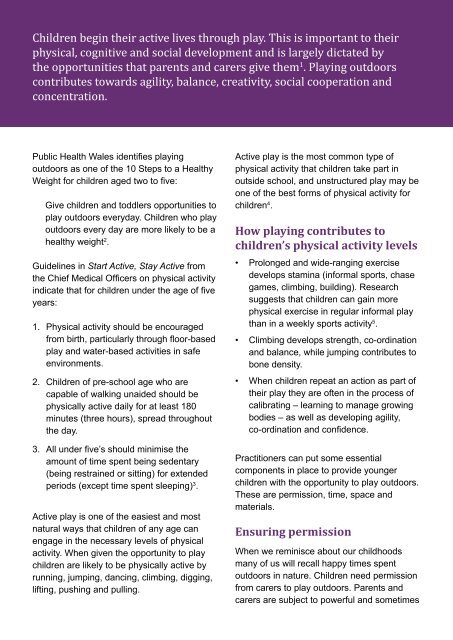Create successful ePaper yourself
Turn your PDF publications into a flip-book with our unique Google optimized e-Paper software.
Children beg<strong>in</strong> their active lives <strong>through</strong> <strong>play</strong>. This is important to their<br />
<strong>physical</strong>, cognitive and social development and is largely dictated by<br />
the opportunities that parents and carers give them 1 . Play<strong>in</strong>g <strong>outdoor</strong>s<br />
contributes towards agility, balance, creativity, social cooperation and<br />
concentration.<br />
Public Health Wales identifies <strong>play</strong><strong>in</strong>g<br />
<strong>outdoor</strong>s as one of the 10 Steps to a Healthy<br />
Weight for children aged two to five:<br />
Give children and toddlers opportunities to<br />
<strong>play</strong> <strong>outdoor</strong>s everyday. Children who <strong>play</strong><br />
<strong>outdoor</strong>s every day are more likely to be a<br />
healthy weight 2 .<br />
Guidel<strong>in</strong>es <strong>in</strong> Start Active, Stay Active from<br />
the Chief Medical Officers on <strong>physical</strong> <strong>activity</strong><br />
<strong>in</strong>dicate that for children under the age of five<br />
<strong>years</strong>:<br />
1. Physical <strong>activity</strong> should be encouraged<br />
from birth, particularly <strong>through</strong> floor-based<br />
<strong>play</strong> and water-based activities <strong>in</strong> safe<br />
environments.<br />
2. Children of pre-school age who are<br />
capable of walk<strong>in</strong>g unaided should be<br />
<strong>physical</strong>ly active daily for at least 180<br />
m<strong>in</strong>utes (three hours), spread <strong>through</strong>out<br />
the day.<br />
3. All under five’s should m<strong>in</strong>imise the<br />
amount of time spent be<strong>in</strong>g sedentary<br />
(be<strong>in</strong>g restra<strong>in</strong>ed or sitt<strong>in</strong>g) for extended<br />
periods (except time spent sleep<strong>in</strong>g) 3 .<br />
Active <strong>play</strong> is one of the easiest and most<br />
natural ways that children of any age can<br />
engage <strong>in</strong> the necessary levels of <strong>physical</strong><br />
<strong>activity</strong>. When given the opportunity to <strong>play</strong><br />
children are likely to be <strong>physical</strong>ly active by<br />
runn<strong>in</strong>g, jump<strong>in</strong>g, danc<strong>in</strong>g, climb<strong>in</strong>g, digg<strong>in</strong>g,<br />
lift<strong>in</strong>g, push<strong>in</strong>g and pull<strong>in</strong>g.<br />
Active <strong>play</strong> is the most common type of<br />
<strong>physical</strong> <strong>activity</strong> that children take part <strong>in</strong><br />
outside school, and unstructured <strong>play</strong> may be<br />
one of the best forms of <strong>physical</strong> <strong>activity</strong> for<br />
children 4 .<br />
How <strong>play</strong><strong>in</strong>g contributes to<br />
children’s <strong>physical</strong> <strong>activity</strong> levels<br />
• Prolonged and wide-rang<strong>in</strong>g exercise<br />
develops stam<strong>in</strong>a (<strong>in</strong>formal sports, chase<br />
games, climb<strong>in</strong>g, build<strong>in</strong>g). Research<br />
suggests that children can ga<strong>in</strong> more<br />
<strong>physical</strong> exercise <strong>in</strong> regular <strong>in</strong>formal <strong>play</strong><br />
than <strong>in</strong> a weekly sports <strong>activity</strong> 5 .<br />
• Climb<strong>in</strong>g develops strength, co-ord<strong>in</strong>ation<br />
and balance, while jump<strong>in</strong>g contributes to<br />
bone density.<br />
• When children repeat an action as part of<br />
their <strong>play</strong> they are often <strong>in</strong> the process of<br />
calibrat<strong>in</strong>g – learn<strong>in</strong>g to manage grow<strong>in</strong>g<br />
bodies – as well as develop<strong>in</strong>g agility,<br />
co-ord<strong>in</strong>ation and confidence.<br />
Practitioners can put some essential<br />
components <strong>in</strong> place to provide younger<br />
children with the opportunity to <strong>play</strong> <strong>outdoor</strong>s.<br />
These are permission, time, space and<br />
materials.<br />
Ensur<strong>in</strong>g permission<br />
When we rem<strong>in</strong>isce about our childhoods<br />
many of us will recall happy times spent<br />
<strong>outdoor</strong>s <strong>in</strong> nature. Children need permission<br />
from carers to <strong>play</strong> <strong>outdoor</strong>s. Parents and<br />
carers are subject to powerful and sometimes


